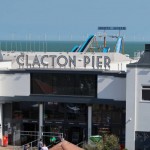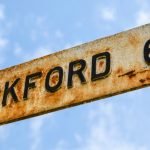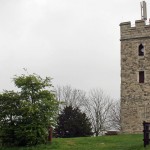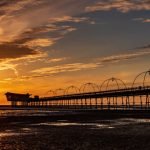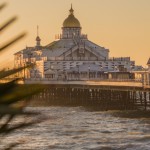Southend-on-Sea is obviously as hard to read as it is to write, probably why the local people refer to it as Southend. We will similarly drop the second half of the name in the hope that you know the place we mean… the one with the long pier & seaside resort attached…
So what secrets is this seaside splendour hiding from us here at Five Minutes Spare? You know we weren’t going to be able to sleep at night until we found out…
Early Southend
Southend was thus named because it was formed at the southern end of the village of Prittlewell. It was a poor village, comprised of only a few ramshackle huts, but it’s inhabitation can be traced all the way back to around the 6th century. It is believed that the nearby church of St. Mary’s was originally erected at that time. The Borough Council record that the church has since been rebuilt so that what stands now was mostly built in the 12th and 15th centuries. It is also noted that you can see the remains of the earlier Saxon church, indented into the northern side of the building.
The council also record that the church is written of in the Domesday Survey. This would put it as operational in 1086. It was named as part of the village of Prittlewell, which had 36 households. In those days, that made the village one of the larger of its kind. The land belonged to Swein of Essex and was one of the hundred of Rochford. It was mainly an area where animal husbandry was practised. The book reports nearly 200 sheep – a fortune back then.
Throughout the middle ages, Southend grew to become a place of its own. It was a market town, bustling its way through the ages. Unfortunately, only two or three parts of town still remain as evidence to this. Some of Victoria Avenue was built during this time and still shows its age. The town went on to have a fairly successful and quiet few hundred years. Nothing notable happened in this small town. In fact, when plague hit in 1346 there is no record of it hitting this town. Then again in 1665 – other towns were ravished, while Southend-on-Sea escaped unscathed.
Interestingly, there was a point of action in 1668, when the HMS London exploded a mile from Southend pier. This resulted in that area of water being closed off entirely and the shipping route moved. Some 300 lives were lost in the explosion. Apparently, the port authority named it a protected wreck, so you need permission to approach, even to this day. We wonder how many of them are still down there…?
In the 1790’s a local landowner sold off two strips of land to developers. This land lay to either side of the modern day high street and was bought up by the Grand Hotel and the Grove Terrace. This sparked the beginning of unstoppable growth throughout the industrial era. It was this growth, combined with the Victorian want to bathe in the sea for its reputed health benefits, that made Southend become so popular in the coming few hundred years.
Famous People from Southend-on-Sea
Let’s take a momentary historical break and skip forward a few years. How many famous people have come from Southend? Who were they or who are they? We already found out, don’t panic. If you come from Southend you come from the same place as:
- Angie Best – former Play Boy bunny and first wife of the footballer, George Best.
- Author Brian Cleeve, famous for writing more than a hundred short stories, was from Southend.
- Lara Pulver, who shot to fame playing Erin Watts in tv show; Spooks.
- Jack Monroe – famed author of the blog ‘a Girl Called Jack’ is from Southend.
- Sir Graham John Hills, Head of the University of Strathclyde and Very Smart Man, is from here.
There are a whole load of Southend stars. Nowadays, it has a very strong music and arts scene and it often pushes out some fantastic session musicians and artistic collaborators. And the odd occultist author… Murry Hope. On that note, let’s get back to the history.
The Industrial Revolution Changed Southend
It changed every city, but for some reason Southend got hit really hard. Probably because Queen Victoria’s era saw sea bathing become a trend. Noble folks flooded to the seaside and little towns suddenly became holiday destinations. Just think… before Victorian times and definitely before trains were invented, people never had holidays because they couldn’t travel that far.
Up until the trainline came through this area, it would have been a sleepy little town. When they added a train station? It changed almost overnight. Up until then there was no way to get to the coast from London… after this, the coast was open and Southend was one of the nearest shores for those that needed to get out of town. It wasn’t just holiday makers, either. People came out to Southend to visit, loved it, and moved there. The railway has allowed Southend-on-Sea to be one of the prettiest commuter towns for the capital, ever since.
Around 1800, one James Heygate was listed as the main property owner. He made several improvements around town and was generally liked. In the nest year, Lord Nelson[i] would spend time in and around the town. His men were defending the nearby Thames Estuary and his flagship rested nearby. Perhaps but not definitely related – the Princess Charlotte (George IV’s daughter) visited after her doctors espoused the benefits of salty air and seawater to her. 1801 was the yar of the first royal visit. It kickstarted an era of growth that saw Southend-on-Sea become what it is today.
Rapid Expansion of a Town
By 1829, the first pier was being built. Southend had grown from part of someone else’s town to be big enough to need a pier. The first stone was laid in July by the Lord Mayor of London – who was probably there on his holidays. Even though the town had grown substantially, it hadn’t yet been identified as its own place. In 1842 St. John’s the Baptist Parish Church was opened and Southend was free of the jurisdiction of Prittlewell.
In 1850 the town got a fresh burst of tourism. It was found to contain natural waters and it became famed for its drinking fountains. Mineral water firms sprang up – but one notable water-based attraction rung out. The vessel Charles Darwin used to tour the world was known as The Beagle. It retired to Southend to be a coastguard vessel.
In 1860 the town had grown to need its own version of the early shopping mall… the shopping street. Nelson Street was built and is still busy today. By 1865 the town had outgrown St John’s parish and a second church was built. Two years later the old barracks at Shoebury were built which saw even more influx of foot traffic into town. A third church was added (St Peter’s and St Paul’s) to accommodate the students of the Shoeburyness British School of Gunnery. You can always rely on churches to mark the growth of a population when you don’t have exact numbers.
In 1885 that same church was forced to add a memorial. An accident in the Shoeburyness royal artillery ranges killed 7 men. The gunners were experimenting with a newly invented type of fuse which proved inadequate. They were fully trained, knew what they were doing, and were ordered to try out the fuses. Unfortunately, back-in-the-day there were no robots or crash-test dummies to try this stuff out. We had to rely on trial and error. The 1860’s saw steamers cross the estuary back and forth on pleasure cruises[ii].
In the 1870’s a convent was set up at Westcliffe, this would later become the girl’s school. The fire brigade was funded and set up a year after the police force established their building and presence in ’74. 1880 saw massive building work throughout the town as the people fought to accommodate the influx of new inhabitants. This area today is conserved. It was also during this time period that the Plough Hotel went up. It still stands to this day!
An earthquake is recorded to have damaged the pier in 1884 and shortly after that the train line was extended out to Shoebury. The pier was damaged by another storm in 1898 – and thus started the history of problems with this structure. However, the town continued to prove a popular seaside resort. By the turn of the century, it opened another three hotels. Already, the town was reaching city numbers in terms of population – but it still had some way to go before it reached nearly 200k[iii] residents as it has today.
Let’s talk fun facts about Southend before we hit the 20th century… there are bound to be some surprises lurking among these streets!
Fun Facts about Southend-on-Sea!
Everyone needs a little fun in these troublesome times… Here are some of the Five Minutes Spare favourite facts about Southend, to cheer us all up!
- The original pier was rebuilt so many times that they stopped recording it. It’s had some trouble, mostly due to bad weather. The original wooden pier is long since lost, and the one that exists today is cast in iron. This solid iron pier is 2.185km long, making it the longest pier in the UK. That’s pretty impressive – but you don’t want to be walking it in stormy weather.
- Parts of Goldfinger were filmed here. The airport road, specifically. Why they would move a whole production out here for one scene, we have no idea. They should have just CGI’d it (yes, yes, we’re kidding).
- It’s the biggest town in Essex… but still not a city. Hang on in there Southend, one day.
- You can fish off the pier if you buy a day pass. That’s 2km of fishing space. Alternatively, catch some of the 7-mile long coastline that frames the town.
- During WWII the town was renamed HMS Westcliff and was sealed off. Nobody was allowed in or out that wasn’t either military, or the family of military members[iv]. To this day, the descendants of Southend have military blood in their veins!
And that short summary of interesting Southend facts brings us back to the 1900’s. What did this seaside resort get up to during two world wars? Let’s start with the first one.
1900’s Southend
In 1900 the Cricket Club became a thing, followed by the opening of the first telephone exchange. In the month of July, a fire tore through the entire centre of town. This made for further expansions to the fire service and was caused by three barrels of benzoline being left out in summer. Southend, by the way, is one of the most temperate places in the UK. It is both the warmest and the driest…
In 1905 it is recorded that the Estuary froze in winter, with one of the coldest on record. Shoebury got its own fire brigade and the Chamber of Trade opened. 1906 saw the purchase of yet more land for the military, and Westcliff bowling Club was opened. So was the library. A cinema was added alongside tramways two years later. The pier was extended only for a ship to crash into it in a horrendous storm in November. Shoebury Palace opened in 1913 followed by two consecutive royal visits in 1916 and 17. The following years saw massive changes and additions to the town.
In 1915, during May, a Zeppelin bombed Southend. The German Zeppelins caused untold damages and a single death. The zeppelins were highly inefficient and weren’t really designed to knock out civilians. They were, however, an ominous portent of the Luftwaffe that was to come. During WWII, some 752 bombs (that we know about) were dropped on Southend.
Fortunately, the children of Southend were evacuated north to quieter climes. The total cost of the bombings were 29 men, 24 women and 394 serious injuries. During some fire bombings it is reported that the whole area turned out to put out the flames. Whatever else Southend-on-Sea might be, it is also a beacon of community spirit when times get tough.
Attractions in Southend
Now that we have covered the historical points, let’s talk about the attractions. There are loads of things to get up to by the sea if you come here on holiday. Let’s face it – many of you do!
Historic Sights and Landmarks
Both the Pier and Old Leigh are locations that are filled with history, you will find both almost as soon as you start exploring the town. However, history buffs should head out to Hadleigh Castle, where the Royals used to come to visit the seaside. It’s now in ruins, of course, but if you want stunning pictures then this is your place.
Another historical option is Hadleigh Farm. They have bred rare animals here for years and the kids absolutely adore the place. For adults, they have a lovely stately home you can peruse. The Salvation Army actually own it, so any entry fee is for a good cause.
Military lovers can also head out to the Shoebury Garrison Conservation Area. This is where generation upon generation of soldiers has trained – all the way back to the 17th century. The area has been conserved since 2004 and we’re not sure we would go there to let the kids run loose. There might be weaponry on the grounds, you never know.
Beaches, Beaches… and a few more Beaches
Try Chalkwell Beach which is near the park, for a popular sunbathing spot. You can also visit Old Leigh and stroll along the pier and sand there. This is an old fishing village which represents the most anciently inhabited area of the town. We would highly recommend that you pop into the Leigh Heritage Centre while you are in the area. It’s a great way to find out about all the old buildings and old industries the town has seen over the years.
Alternatively, visit Shoebury East Beach for a quieter spot, Thorpe Bay Beach for some exploring, or Westcliff beach because why not? We imagine you get the picture… 7 miles of coastline though. That’s a lot of beach.
Southend Football
Southend United are the main football team in the area. They are in the FA cup and play at Roots Hall Stadium You can take a tour, but they are due to move to Fossets Farm Stadium if they haven’t already done so by the time you get there. Either makes a good afternoon out for the fans, though.
Shopping and Retail
There are more than ample shopping centres here. Try the Royal’s Shopping Centre or the Victoria Shopping Centre to start with.
Museums and galleries
Although not technically a museum or a gallery, the Palace Theatre is a great place to catch a show while you are on vacation. One of the cutest little galleries in town is the Two Tree Gallery, definitely pop in and browse some local artwork. If it isn’t to your taste there is also the Beecroft Art Gallery, and a dozen or so other little places dotted around town.
As for Museums, the Central Museum will tell you all about the area and you can find it on Victoria Avenue. It’s… central and has its own planetarium, which is really cool for the kids. The Prittlewell Priory Museum is a little interesting acquisition of the town. It tells the story of the old building, dating back as far as the 12th century!
Outdoor, Nature and Recreation
Adventure Island – this is one of the biggest sights to see in Southend. This amusement park will chuck you out if you don’t have a shirt on in high summer – but your kids will kill you for it. It’s tremendous amounts of fun and even has its own rollercoaster. Go see it! Admission is free so there’s no excuse for not taking a look.
There is a Sealife Adventure Park in Southend that mixes aquarium with learning fun. You will also have your pick of outdoor play and picnic parks. There is a lovely park by the Priory Museum. Chalkwell Park, and any number of lengths of pier to hike. You will also find things to do like fishing, shopping, and eating all along that pier.
Where to Eat, Drink, and Party in Southend?
Southend has its own casino, for those that like the thrill of gambling. Provided you are old enough to place a bet, visit the Rendezvous in Southend. If all you want is a nice meal with your family then the Legend Deli has some awesome street food. Taking out your Mother-in-Law? Provided you like her, try the Roslin Beach Hotel Restaurant. Want to impress a date? The Monti Ristorante Italiano will tend your every need.
Both Route 5 and Mawson’s Micro Pub have good reputations for their cocktail provisions. If you would prefer to dance the night away, then Talk nightclub is reputedly the best around. It’s certainly the longest serving. It’s been in place since the 70’s. If all you want is a stiff pint and a place to watch the match, try the Angel Inn. It’s full of regulars though, don’t blame us if they stare…
How to Get There?
How do you get to this lovely holiday destination?
By Road
Head east from London on the A127, you can’t miss it. It’s at the mouth of the Thames Estuary.
By Rail
Southend Victoria Station, or SOV, is your most central location station.
By Sea
Again – the entrance of the Thames Estuary, north side.
By Air
Londoners love it so much it got its very own airport. Look for London Southend Airport, which is very imaginatively named.
Got Five Minutes?
If you are still looking for entertainment, after all, that then head over to our home page and have a browse. We have loads of lifestyle articles that will help keep you amused in months to come. All you have to do is read!
[i] https://www.southendtimeline.com/1801.htm
[ii] https://towerapartments.co.uk/2018/05/01/12-interesting-facts-about-southend-on-sea/
[iii] https://en.wikipedia.org/wiki/Southend-on-Sea
[iv] https://www.alanblunden.co.uk/16-facts-about-southend-on-sea/
